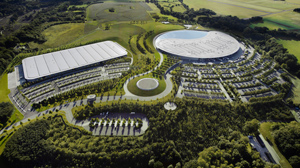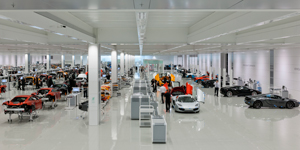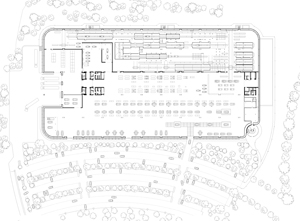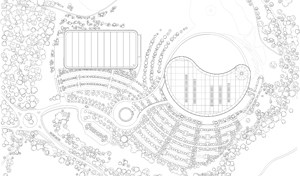 |
 |
 |
 |
 |
 |
| |
 |
|
 |
 |
 |
  |
  |
 |
 |
 |
 |
|
|
 |
|
 |
 |
 |
OPERA |
 |
|
 |
|
 |
 |
 |
| |
 |
| 
 |
McLaren Production Centre
|
|
 |
 |
 |
 |
PROGETTISTA |
 |
|
|
 |
|
 |
 |
 |
| |
 |
|
 |
 |
 |
 |
DESCRIZIONE |
 |
|
|
 |
|
 |
 |
 |
|
|
 |
 The McLaren Production Centre is the second building designed by Foster + Partners at McLaren’s rural site on the outskirts of London. The 34,500-square-metre facility is intended for the manufacture of a range of high-performance road cars and is located to the south-west of the existing McLaren Technology Centre. The two buildings will be connected by a subterranean walkway, lined with interactive exhibition spaces. Sharing a common language of details and materials, the new building is clad in aluminium tubes, the rounded corners of its rectilinear plan reference the curves of the Technology Centre and the entrance, echoing the existing building, is a circular glass drum beneath the overhang of the roof canopy. The McLaren Production Centre is the second building designed by Foster + Partners at McLaren’s rural site on the outskirts of London. The 34,500-square-metre facility is intended for the manufacture of a range of high-performance road cars and is located to the south-west of the existing McLaren Technology Centre. The two buildings will be connected by a subterranean walkway, lined with interactive exhibition spaces. Sharing a common language of details and materials, the new building is clad in aluminium tubes, the rounded corners of its rectilinear plan reference the curves of the Technology Centre and the entrance, echoing the existing building, is a circular glass drum beneath the overhang of the roof canopy.
 The MPC further develops an approach to industrial architecture that was first explored in some of the practice’s earliest projects for Reliance Controls and Renault. The roof canopy is supported by a series of slender columns based on a standard grid with repeated components, and services are integrated with the painted steel structure. McLaren’s manufacturing processes are closer in spirit to an operating theatre than a factory and the new building, with its ceramic tiled floors, is designed to showcase this technology. The linear arrangement of the two-storey structure mirrors the flow of the production line: components are delivered; the cars are assembled, painted and tested, and then pass through a rolling road and car wash, before leaving the building. Below this is a basement level for storage and above is a mezzanine floor with views over the production line. The MPC further develops an approach to industrial architecture that was first explored in some of the practice’s earliest projects for Reliance Controls and Renault. The roof canopy is supported by a series of slender columns based on a standard grid with repeated components, and services are integrated with the painted steel structure. McLaren’s manufacturing processes are closer in spirit to an operating theatre than a factory and the new building, with its ceramic tiled floors, is designed to showcase this technology. The linear arrangement of the two-storey structure mirrors the flow of the production line: components are delivered; the cars are assembled, painted and tested, and then pass through a rolling road and car wash, before leaving the building. Below this is a basement level for storage and above is a mezzanine floor with views over the production line.
The expansion of the campus is a similarly discreet intervention in the landscape. Rising to just over 7 metres in height and embedded in the gentle incline of the site, the MPC is sensitive to its rural setting and will not be visible from the nearby road. Further screening will be provided by the extensive planting of trees and excavated material will help to conceal the building within the hill. The new building is also designed to be sustainable – the Technology Centre uses the lake for its cooling system, so the roof of the MPC supports this by collecting rainwater and implementing a low-energy system of displacement ventilation.
|
|
 |
 |
 |
|
 |
|
| Scale comparisons |
 |
|
 |
 3 jumbo jets can fit in the floor plan area 3 jumbo jets can fit in the floor plan area
- 2,469 F1 cars could fit in the ground floor plan area
- If all the 218,000 ceramic tiles specified were laid end to end they would stretch from London to Reading
- If all the steel columns were stacked on top of each other they would reach a height of 895m, almost 3 times the height of the Eiffel tower (324m)
- 180,000m3 of soil excavated. This would fill level +1 and Ground level of McLaren Technology centre
|
|
 |
 |
 |
 |
 |
 |
 |
MATERIALI |
 |
|
|
 |
|
 |
 |
 |
 |
 |
|
acciaio, cemento armato 1,500 piles, each around 14 m in length
210,000 m3 of concrete with typical pour sizes of 500m3
9,200 m2 of blockwork equating to 92,000 blocks
1,500 tonnes of structural steelwork makes up the frame, 30 pieces of steel erected each day throughout the programme
Approximately 200,000 m3 of material was excavated as part of the basement box construction, including the temporary batter
Cladding
Glazed walls
Aluminium tubes
9m panels
|
|
 |
 |
 |
 |
ECOSOSTENIBILITA' |
 |
|
|
 |
|
 |
 |
 |
|
|
 |
 Although the McLaren Production Centre represents a major increase in McLaren’s capabilities at its Woking campus, the building is dug into in the gentle incline of the site, to give it a discreet presence in the landscape. The lower floor is sunk completely below ground and the superstructure is almost invisible from the nearby road, with further screening provided by extensive tree planting. Although the McLaren Production Centre represents a major increase in McLaren’s capabilities at its Woking campus, the building is dug into in the gentle incline of the site, to give it a discreet presence in the landscape. The lower floor is sunk completely below ground and the superstructure is almost invisible from the nearby road, with further screening provided by extensive tree planting.
The new McLaren Production Centre is designed to be environmentally efficient. The roof collects rainwater and has been designed to integrate photovoltaic panels in future; and the building incorporates a low-energy system of displacement ventilation. No soil was removed from the site, and all excavated material has been used to conceal the building within the green-belt landscape.
- 34% reduction in CO2 emissions by design from ADL2A baseline
- 820 new trees - 68 existing mature trees replanted on site before birdnesting season
- The paint shop requires no air conditioning - a conventional paint shop would require an additional 2.5 megawatts to operate
- 180,000m3 of soil displaced during construction retained on site and reused in the landscaping project to screen the MPC from view
|
|
 |
 |
 |
 |
 |
 |
 |
LOCALIZZAZIONE |
 |
|
|
 |
|
 |
 |
 |

|
 |

|
Continente |
|
 |
  Europa |
|
Nazione |
|
 |
  Gran Bretagna [United Kingdom] |
|
Stato |
|
 |
  Inghilterra [England] |
|
Regione |
|
 |
  South East |
|
Contea |
|
 |
  Surrey |
|
Distretto |
|
 |
  Woking |
|
Città |
|
 |
  Woking |
|
Indirizzo |
|
 |
  Chertsey Road, GU21 4YH Woking (Guilford Road)
|
|
|
|
 |
|
Sito web |
|
 |
|
 |
 |
 |
 |
MAPPA |
 |
|
|
 |
|
 |
 |
 |
| |
 |
|
 |
 |
 |
 |
|
TIPOLOGIA |
 |
|
|
 |
|
 |
 |
 |
|
|
 |
ARCHITETTURA | Edifici e impianti industriali
Aziende, fabbriche, laboratori
| |
 |
 |
 |
 |
CRONOLOGIA |
 |
|
|
 |
|
 |
 |
 |
Progetto |
 |
|
 |
| 
 |
2009
|
|
Realizzazione |
 |
|
 |
| 
 |
2010 - 2011 |
|
 |
 |
 |
 |
PREMI |
 |
|
|
 |
|
 |
 |
 |
| 2012 |
 |
|
 |
Judges Special Award
BCIA British Construction Industry Awards |
|
 |
 |
 |
 |
 |
 |
 |
RIFERIMENTI BIBLIOGRAFICI |
 |
|
|
 |
|
 |
 |
 |
|
 |
| "McLaren Automotive. Foster & Partners", Blueprint 291, june 2010, p. 31 |
|
 |
 |
 |
 |
 |
 |
 |
COMMITTENTE |
 |
|
|
 |
|
 |
 |
 |
| |
 |
|
 |
 |
 |
 |
DATI
DIMENSIONALI |
 |
|
|
 |
|
 |
 |
 |
| Superficie |
 |
|
 |
totale mq. 34.500
piano terreno mq. 19.223
interrato mq. 13.167 (escluso tunnel)
impianti esterni mq. 620 |
|
| Altezza |
 |
|
 |
edificio: ml. 6,60
piano terreno ml. 5,00 (altezza utile)
interrato ml. 4,00 (altezza utile) |
|
| Lunghezza |
 |
|
 |
edificio: ml. 200
tunnel fra il centro visitatori e MPC: ml. 100 |
|
| Larghezza |
 |
|
 |
|
| Piani |
 |
|
 |
|
| Dimensioni |
 |
|
 |
Griglia strutturale
piano terreno: ml. 21 x 18
interrato: ml. 9 x 9 |
|
| Capienza |
 |
|
 |
Parcheggio
400 posti auto
76 spazi per biciclette |
|
 |
 |
 |
 |
STRUTTURISTA |
 |
|
|
 |
|
 |
 |
 |
| |
 |
|
 |
 |
 |
 |
ARCHITETTURA DEL PAESAGGIO |
 |
|
|
 |
|
 |
 |
 |
| |
 |
|
 |
 |
 |
 |
STAFF |
 |
|
|
 |
|
 |
 |
 |
Progetto  |
 |
|
|
 |
|
|
 |
|
Responsabili del progetto |
 |
| Norman Foster, David Nelson, Nigel Dancey |
|
Gruppo di progettazione |
 |
| Iwan Jones, Dominik Hauser, Nina Linde, Chris Johnstone, Kathleen Mark, Nicholas Papas |
|
Impianti |
 |
|
Consulente per energia e ambiente |
 |
|
Controllo costi |
 |
|
 |
 |
 |
 |
PROGETTI CORRELATI |
 |
|
|
 |
|
 |
 |
 |
| |
 |
|
 |
 |
 |
 |
CREDITS |
 |
|
|
 |
|
 |
 |
 |
| |
 |
Text edit by Foster + Partners
Photos © McLaren, © Nigel Young
Drawings © Foster + Partners
Courtesy by Foster + Partners
|
|
 |
  |
 |
|
|